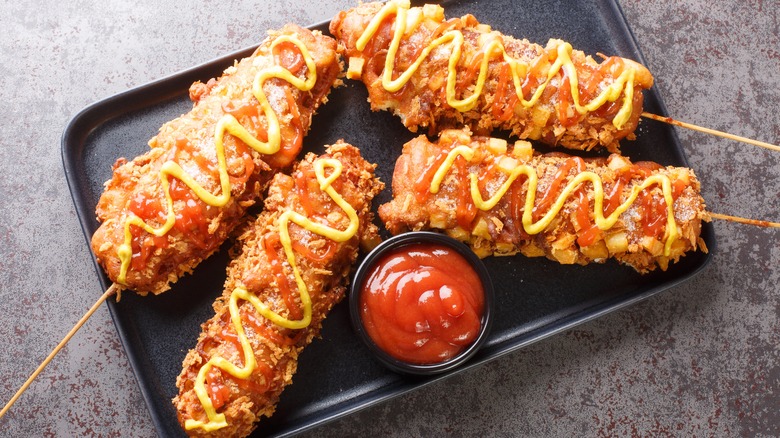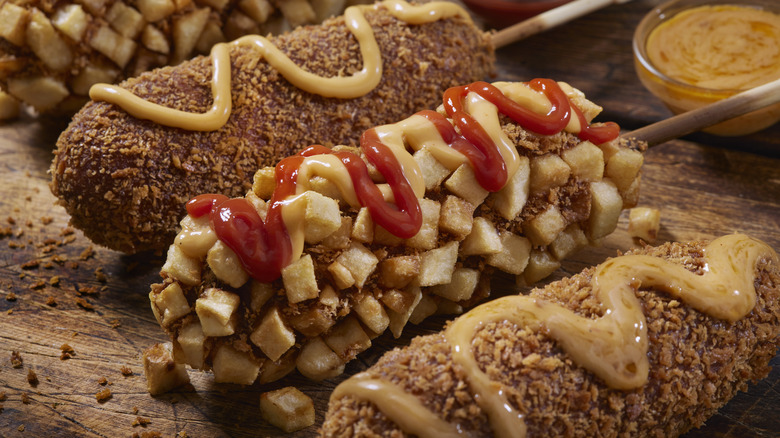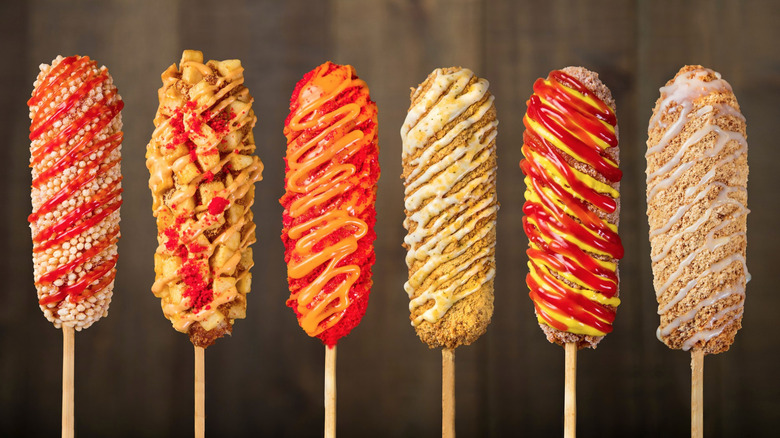What Exactly Is A Korean Corn Dog?
When it comes to meat on a stick, the almighty corn dog reigns supreme. Corn dogs are ubiquitous everywhere from county fairs and grocery stores to street vendors and ballparks. But in recent years, a newer type of corn dog has been gaining popularity: Korean corn dogs.
Given America's growing appetite for Korean food, it only makes sense that our collective fascination would eventually expand beyond the realm of kimchi and hungrily subsume something a little more familiar. Perhaps no other food better exemplifies the comforting fusion of simple American fare and Korean cuisine than Korean corn dogs. That said, Korean corn dogs are still a relatively new trend that many people still may have not tried. Lingering questions about how they're made and how they're different from American corn dogs — among other inquiries — may abound. We're here to put a spotlight on these tasty meatsicles and highlight some of the basics to help keep you in the loop.
What is a Korean corn dog?
Korean corn dogs offer a Korean twist on traditional American corn dogs. In short, Korean corn dogs tend to feature more ingredients, fillings, seasonings, and sauces than American corn dogs. Similar to American corn dogs, Korean corn dogs are made with processed sausages that are coated in batter, deep fried in piping hot oil until they're golden brown, and often served with ketchup and mustard. But that's where the similarities end.
Korean corn dogs tend to include more ingredients in the batter to add more interesting flavors and textural contrast. They are also often rolled in sweet and savory seasonings, such as crushed ramen noodles or white sugar, after coming out of the fryer. On the surface, for many Americans, some of these additional toppings may seem a bit strange. While the inclusion of sweeter ingredients in this context may feel out of place from our perspective, it's important to remember that we have our own versions of food that walk the line between sweet and savory. Fried chicken and waffles, Monte Cristo sandwiches, and caramel corn are just a few examples of our own culinary expressions that embrace stark flavor contrasts. At the end of the day, the world is a far more interesting place thanks to our differences, including food culture.
How are Korean corn dogs made?
Korean corn dogs are made with a thick yeasted batter that doesn't include cornmeal. Instead, rice flour is typically used. Sausages are often wrapped in cheese (such as sticks of mozzarella) and then battered and fried. Chunks of diced potato or chopped french fries are also occasionally mixed into the batter. Simple yet brilliant, this fuses all the flavors and textures of corn dogs and crunchy potatoes, conveniently and deliciously delivering them into a single bite.
Sauces are often drizzled on top of Korean corn dogs after they come out of the fryer. While classic condiments such as ketchup and mustard are used, less traditional sauces such as sweet chili sauce or honey mustard may also be paired with Korean corn dogs. This affinity for sweetness paired with savory ingredients is extremely popular in Korean cuisine. In fact, pizzas in Korea are often topped with honey mustard and other sweet sauces; branches of Pizza Hut have been known to roll out seasonal surf and turf pizzas with sweet cranberry cream cheese crust.
The history and future of Korean corn dogs
Corn dogs in Korea started as a street food in the 1980s, but new twists on it emerged in Busan around 2016. As a coastal metropolis, Busan is mostly known for its seafood markets and beloved for its regional yet famous pork soup, dwaeji gukbap. When it comes to street food in Busan (and Korea at large) the usual offerings include steamed dumplings, stir-fried rice cakes drenched in spicy sauce, and Korean-style fried chicken. Yet after Myungrang Hot Dog launched in Busan and offered a new spin on the country's corn dogs, its creative flavor combinations proved so popular that the chain rapidly expanded to 650 locations across Korea in just the span of three years. The emergence of social media platforms like Instagram and TikTok helped fuel a craze that eventually brought Korean corn dogs to the US.
Americans have been consuming the same type of corn dog for generations; it was only a matter of time before new interpretations of it reawakened consumers to its culinary potential. Now that the Korean corn dog has arrived, there's no reason to believe its days are numbered. Food trends come and go, but America's growing enjoyment of Korean food along with its historical love of hot dogs seems to indicate that Korean corn dogs are here to stay.
Types of Korean corn dogs
Unlike American corn dogs, which don't tend to stray much from the same basic recipe, Korean corn dogs offer more variety. In its most simplistic form, Korean corn dogs come rolled in sugar and then drizzled with ketchup and mustard. But this standard offering really only just scratches the surface of what's available.
Potato corn dogs (known as gamja hotdogs in Korean) are one of the most popular types of Korean corn dogs. Other types of Korean corn dogs include corn dogs stuffed with cheese and topped with rice cakes or crunchy ramen noodles. Korean corn dogs topped with rice cakes or ramen noodles have an exceptionally crunchy texture since the batter is rolled in crushed bits before it is deep fried.
Korean corn dogs are also topped with other packaged snacks, such as Hot Cheetos. With these corn dogs, Hot Cheetos are crushed into a fine red powder that coats the outermost layer of corn dog batter. This gives these corn dogs a salty yet somewhat spicy kick, since Hot Cheetos are the first ingredient to bite into. Another type of Korean corn dog is made with squid ink. While the squid ink doesn't necessarily impart much flavor, it adds a darker color to the batter that's unique. There are plenty of other types of Korean corn dogs too, so it's worth exploring the different menus available.
Korean corn dogs vs American corn dogs
Korean corn dogs and American corn dogs have similarities and differences. They are both battered sausages on a stick, but the ingredients are often different. American corn dogs tend to be more simplistic and seldom deviate from the standard recipe that we're all familiar with. Korean corn dogs, on the other hand, are far more experimental when it comes to ingredients.
One of the main differences is the batter. American corn dogs prominently feature cornmeal in the batter, which gives them a distinctive flavor and texture. Korean corn dogs often forgo the cornmeal in lieu of rice flour. The batter in Korean corn dogs also tends to be thicker and fluffier, while American corn dogs often feature batter that's thinner yet slightly more dense. The exterior of Korean corn dogs is crispier and the texture of American corn dogs is a bit softer. Korean corn dogs use more sauces and seasonings than American corn dogs. If you dig the flavor contrast of sweet and savory, then there's a good chance that you'll enjoy Korean corn dogs.
Where to buy Korean corn dogs
The good news is that you don't have to travel to the other side of the world to give Korean corn dogs a try — though, we'd still encourage you to eat your way around South Korea sometime. These days, Korean corn dogs can be found in the frozen food section of some grocery stores, including H-mart. If there isn't an H-Mart location near you, then try finding a smaller local Asian market that carries Korean cuisine. There's a good chance that they may have some Korean corn dogs, along with other items like gochujang, kimchi, and Korean-style dumplings.
Aside from some grocery stores and specialty markets, Korean corn dogs can be found at some restaurants. Myungrang Hotdog, credited with kicking off the Korean corn dog trend in Busan, has expanded its operation to locations around the US including California, Arizona, Nevada, Utah, Ohio, and Washington. In New York City, Two Hands Corn Dogs is a popular choice. The menu at Two Hands is highly customizable, offering diners options to select various coatings and sausage types such as spicy sausage or beef sausage. Some of the coatings include fried potatoes, rice puffs, and Flamin' Hot Cheetos. As the popularity of Korean corn dogs spreads, it's worth regularly looking into where they can be found in your area.






